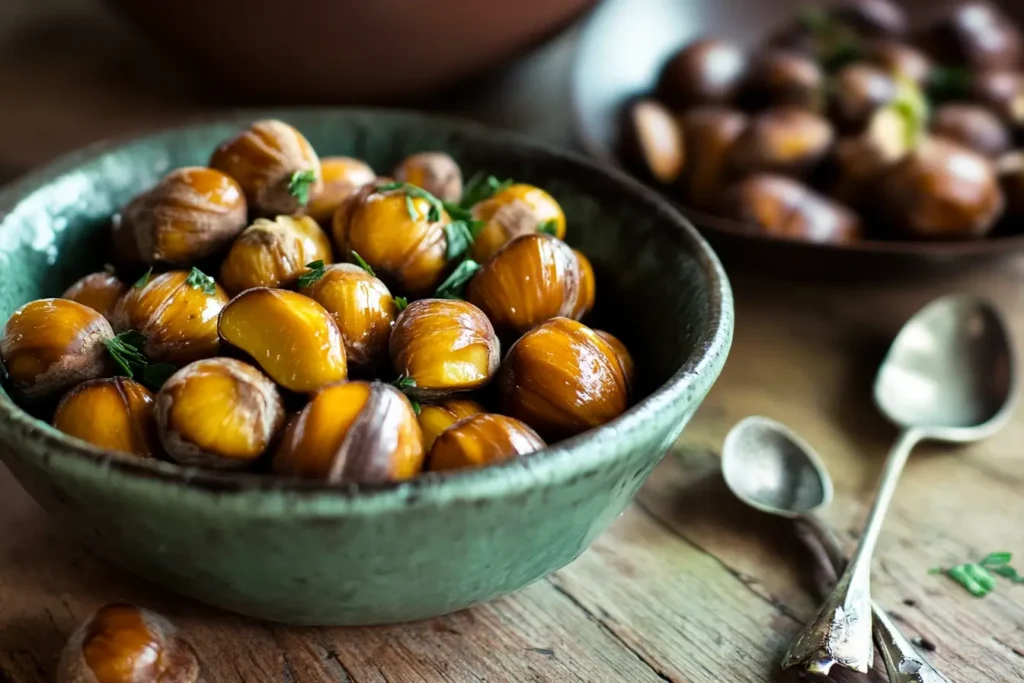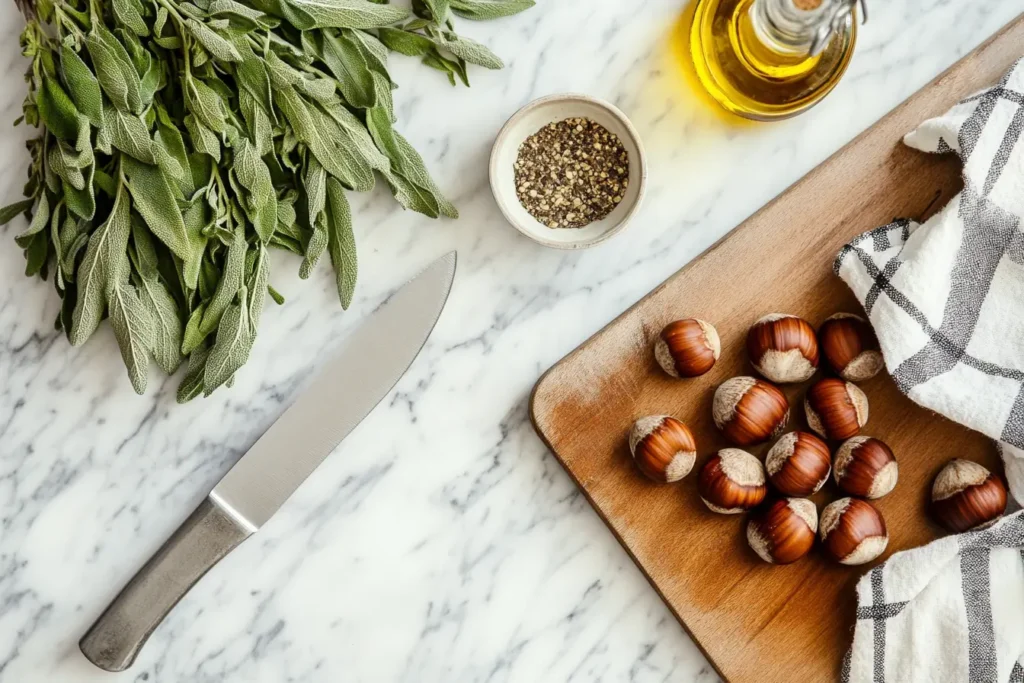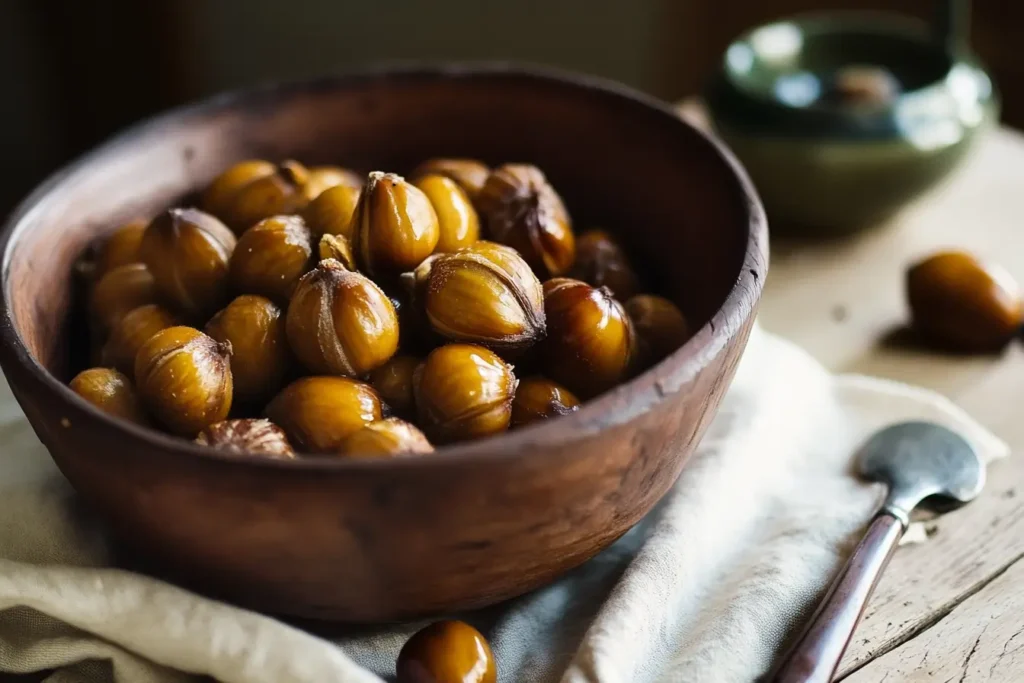There’s something magical about chestnuts recipe. Whether you’re roasting them over an open fire (cue the holiday vibes 🎄) or transforming them into creamy soups and desserts, chestnuts bring a unique flavor and texture to any dish. They’re nutty, slightly sweet, and incredibly versatile. But what makes chestnuts recipe so special? And how can you prepare them to unlock their full potential?
In this article, we’ll explore the culinary magic of chestnuts, from their rich history to step-by-step recipes that will make you fall in love with this seasonal delight. Let’s dive in!

Table of Contents
Introduction to chestnuts recipe and Their Culinary Uses
What Makes Chestnuts Unique in Cooking?
Chestnuts are unlike any other nut you’ve cooked with. For one, they’re naturally lower in fat and calories but higher in starch, which gives them their creamy texture when cooked. This makes them a perfect ingredient for both sweet and savory recipes. From hearty stuffing to decadent desserts, chestnuts add a subtle sweetness and a velvety texture that’s hard to replicate.
They also pair beautifully with seasonal ingredients like apples, pumpkins, and cranberries, making them a go-to for fall and winter dishes.
A Brief History of Chestnuts in Recipes
Chestnuts recipe have been a staple in global cuisines for centuries. In Europe, they’re a key ingredient in French marrons glacés (candied chestnuts) and Italian chestnut flour polenta. In Asia, roasted chestnuts are a street food favorite, especially in China and Korea.
Their popularity spans cultures and continents, proving that chestnuts are truly a timeless ingredient.
For more insights on chestnut preparation, check out this comprehensive guide: How to Cook Chestnuts to Eat.
Nutritional Benefits of chestnuts recipe
Low in Fat, High in Flavor: A Healthy Choice
Chestnuts stand out from other nuts due to their nutritional profile. They’re low in fat but packed with complex carbohydrates, making them a fantastic energy source. Unlike almonds or walnuts, chestnuts are more like a carbohydrate-rich treat that feels indulgent without being heavy.
Packed with Vitamins and Minerals
Chestnuts are a powerhouse of nutrients. They’re loaded with vitamin C, potassium, and magnesium, all of which support overall health. Plus, they’re naturally gluten-free, making them an excellent ingredient for those with dietary restrictions.
How chestnuts recipe Support Digestive Health
Thanks to their high fiber content, chestnuts promote healthy digestion. Incorporating chestnuts into your meals can help you stay fuller longer and maintain a happy gut.
Choosing the Best chestnuts recipe for Cooking
Fresh vs. Packaged Chestnuts: What’s the Difference?
When shopping for chestnuts, you’ll likely come across two main options: fresh and packaged.
Fresh Chestnuts: These have the best flavor but require a bit more prep work, like scoring and roasting.
Packaged Chestnuts: These are pre-cooked and peeled, making them a convenient option for recipes like soups or purees.
Quick tip: If you’re going for fresh, make sure the shells are shiny and smooth, and the nuts feel heavy for their size.
How to Select Quality chestnuts recipe at the Market
Look for chestnuts with firm shells that don’t rattle when shaken. A rattling sound means the nut inside has dried out. Fresh chestnuts should also have a mild, sweet aroma.
Seasonal Availability and Storage Tips
Chestnuts are typically in season from late fall to early winter. Store fresh chestnuts in a cool, dry place or refrigerate them to extend their shelf life. If you’ve purchased packaged chestnuts, keep them sealed until ready to use.
Tools You’ll Need to Cook chestnuts recipe
Must-Have Equipment for Roasting Chestnuts
To roast chestnuts, you’ll need a few basic tools:
A Sharp Knife: For scoring the shells.
A Heavy Skillet or Baking Tray: For roasting.
A Towel: To help peel the chestnuts while they’re warm.
Kitchen Gadgets to Make Chestnut Prep Easier
If you’re working with a large batch, consider investing in a chestnut scoring tool or a special chestnut roasting pan with holes to distribute heat evenly.
Safety Tips for Handling chestnuts recipe
Always score your chestnuts before cooking to prevent them from exploding. Yes, that’s right—unscored chestnuts can burst due to steam buildup inside their shells.
For a detailed roasting method, visit Chestnuts Recipe: How to Roast.
How to Cook Chestnuts: Step-by-Step Recipes

Classic Roasted Chestnuts Recipe
Here’s a foolproof way to roast chestnuts:
Ingredients:
1 lb fresh chestnuts
1 tbsp olive oil (optional)
Pinch of salt (optional)
Instructions:
Preheat your oven to 425°F (220°C).
Wash and dry the chestnuts, then use a sharp knife to score an “X” on the flat side of each nut.
Spread the chestnuts on a baking tray in a single layer. If desired, drizzle with olive oil and sprinkle with salt.
Roast for 20-25 minutes, shaking the tray halfway through. The shells should peel back around the scored edges.
Wrap the hot chestnuts in a clean kitchen towel and let them steam for 5 minutes. This makes peeling easier.
Serve warm and enjoy!
Nutrition Facts (Per 1 oz Serving):
| Nutrient | Amount |
| Calories | 69 kcal |
| Protein | 1 g |
| Total Fat | 0.3 g |
| Carbohydrates | 15 g |
| Fiber | 2 g |
| Vitamin C | 15% of the DV |
Nutrient Amount
Calories 69 kcal
Protein 1 g
Total Fat 0.3 g
Carbohydrates 15 g
Fiber 2 g
Vitamin C 15% of the DV
Block Quote:
“Roasted chestnuts are more than a snack—they’re a tradition. From their nutty aroma to their rich, sweet taste, they’re pure joy in a shell. 🌰✨”
Variations and Creative Uses for chestnuts recipe
Chestnut Stuffing for Holiday Feasts
Chestnuts are a game-changer in stuffing recipes. Their nutty flavor and soft texture blend beautifully with herbs, bread, and vegetables to create a dish that screams comfort food.
How to Use Them:
- Chop roasted chestnuts and mix them into your favorite stuffing recipe along with sage, thyme, and onions.
- Pair the stuffing with roast turkey, chicken, or even a vegetarian main dish for a holiday-worthy spread.
This variation isn’t just a side—it’s the star of the table.
Chestnuts in Desserts: Cakes, Tarts, and More
If you’ve never had chestnuts in a dessert, you’re missing out! Their natural sweetness makes them ideal for treats like cakes, tarts, and puddings.
Ideas for Desserts:
- Chestnut Cake: Blend chestnut puree into your cake batter for a moist, rich flavor.
- Chocolate-Chestnut Tart: Pair chestnut puree with dark chocolate for a decadent dessert.
- Marrons Glacés: Try making these classic French candied chestnuts for a festive touch.
For a dessert to round out your chestnut-inspired meal, check out this Fresh Apple Cake Recipe. Its fruity flavors perfectly complement nutty chestnuts.
Chestnuts in Savory Dishes: Pastas, Salads, and Stir-Fries
Chestnuts aren’t just for sweets—they shine in savory dishes too.
- Pastas: Add roasted chestnuts to creamy sauces or toss them with brown butter and sage.
- Salads: Dice chestnuts and toss them into a spinach or arugula salad for a crunchy, earthy addition.
- Stir-Fries: Include chestnuts in vegetable stir-fries for a subtle sweetness and chewy texture.

Common Problems and Solutions When Cooking chestnuts recipe
How to Avoid Undercooked or Overcooked chestnuts recipe
Cooking chestnuts can be tricky—they need just the right amount of heat to soften their starchy interior without drying out.
- Undercooked? Extend roasting or boiling time by 5-10 minutes. Test by piercing the chestnut with a fork; it should slide in easily.
- Overcooked? Unfortunately, over-roasted chestnuts become dry. To save them, mash the chestnuts into a puree with a bit of water or broth for use in soups or sauces.
Dealing with Difficult-to-Peel Chestnuts
Peeling chestnuts is one of the most common complaints, but a little technique can go a long way:
- Score Properly: Make a deep “X” on the flat side to ensure the shell opens during cooking.
- Steam After Roasting: Wrapping roasted chestnuts in a towel and letting them steam for 5-10 minutes loosens the shell.
- Work While Warm: Peel chestnuts as soon as they’re cool enough to handle; the shells become tougher as they cool.
For a step-by-step peeling guide, visit Chestnuts Recipe: How to Roast.
Preventing Chestnuts from Drying Out
Nobody likes dry chestnuts! To keep them moist:
- Store raw chestnuts in the refrigerator or freezer to maintain their natural moisture.
- When roasting, add a small dish of water to your oven to create steam, which prevents drying.
Pairing Chestnuts with Other Ingredients
Sweet Pairings: Chocolate, Honey, and Fruits
Chestnuts pair beautifully with sweet flavors. Here are a few ideas:
- Chocolate: Combine chestnut puree with melted chocolate for an indulgent mousse or cake filling.
- Honey: Drizzle honey over roasted chestnuts for a simple yet delicious snack.
- Fruits: Pair chestnuts with apples, pears, or figs for desserts or savory dishes.
Savory Pairings: Herbs, Meats, and Cheeses
Chestnuts’ earthy flavor also works well with savory ingredients:
- Herbs: Sage, thyme, and rosemary enhance chestnuts in stuffing or pasta dishes.
- Meats: Chestnuts complement roasted poultry, pork, and even duck.
- Cheeses: Pair chestnuts with creamy cheeses like brie or ricotta for appetizers or salads.
Beverages That Complement Chestnut Dishes
Pairing chestnuts with the right drink can elevate your meal:
- Red Wine: A medium-bodied red like Pinot Noir balances chestnuts’ natural sweetness.
- Hot Drinks: Chestnuts pair beautifully with spiced cider or mulled wine during the holidays.
- Coffee or Espresso: Chestnut desserts, like cakes or tarts, shine alongside a strong cup of coffee.
Block Quote:
“Chestnuts are the culinary equivalent of a blank canvas—they’re humble yet elegant, ready to transform into something truly delicious. 🌰✨”
Storing and Reheating Chestnuts
How to Properly Store Fresh and Cooked Chestnuts
To get the best flavor and texture out of chestnuts, proper storage is essential:
- Fresh Chestnuts: Store unpeeled, raw chestnuts in the refrigerator in a breathable bag or perforated container. They’ll last up to two weeks.
- Cooked Chestnuts: Place peeled, cooked chestnuts in an airtight container in the fridge for up to four days.
- Chestnut Puree: If you’ve prepared puree, seal it in an airtight container and refrigerate for up to a week.
Freezing Chestnuts for Long-Term Use
For long-term storage, chestnuts freeze exceptionally well:
- Raw Chestnuts: Freeze whole, unpeeled chestnuts in a zip-top bag for up to six months. Thaw them overnight in the fridge before using.
- Cooked Chestnuts: Peel and freeze cooked chestnuts for up to three months. Use them straight from frozen in soups, stews, or purees.
Tips for Reheating Without Losing Flavor
To reheat chestnuts without sacrificing texture or taste:
- Place cooked chestnuts in a skillet with a splash of water or broth. Heat over medium-low heat until warmed through.
- Alternatively, roast them briefly in the oven at 350°F for 5-10 minutes to bring back that toasty flavor.
Where to Buy Chestnuts and Recipe Ingredients
Finding Fresh Chestnuts at Farmers’ Markets
Farmers’ markets are your best bet for fresh, high-quality chestnuts, especially during peak season in the fall. Look for vendors who sell chestnuts with smooth, glossy shells and no visible mold or cracks.
Online Options for Specialty Ingredients
If you can’t find chestnuts locally, online stores like Amazon, Thrive Market, or specialty food websites offer both fresh and pre-packaged options. These retailers often sell chestnut flour, puree, and even marrons glacés for your cooking needs.
Best Brands for Packaged Chestnuts
Pre-packaged chestnuts are a convenient option for recipes. Here are some reliable brands:
- Gefen Whole Chestnuts: Great for soups and stuffing.
- Clement Faugier: Known for their high-quality chestnut puree and candied chestnuts.
- Melissa’s: Offers fresh and pre-cooked chestnuts in vacuum-sealed packaging.
Conclusion: Why Chestnuts Deserve a Place in Your Kitchen
Chestnuts are more than just a seasonal treat—they’re a versatile ingredient that can transform your cooking. From sweet desserts to savory holiday dishes, chestnuts add a unique flavor and texture that you simply can’t replicate with other ingredients.
Not only are they delicious, but they’re also packed with nutrients like vitamin C, fiber, and magnesium. Whether you’re roasting them for a cozy winter snack or whipping up a batch of chestnut stuffing for Thanksgiving, chestnuts have something to offer everyone.
So, why not experiment with a chestnut recipe this season? You might just discover your new favorite ingredient. 🌰✨
Block Quote:
“Chestnuts aren’t just for the holidays—they’re a year-round secret weapon for adding flavor, texture, and nutrition to your meals.”
